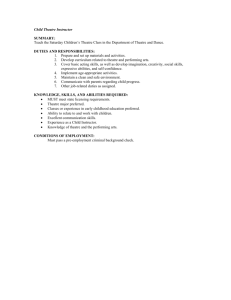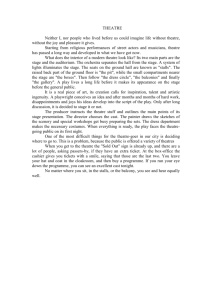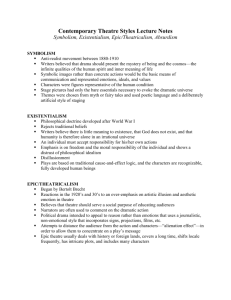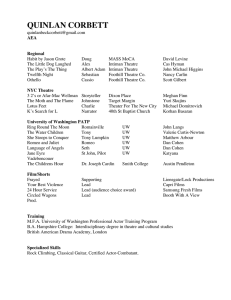THEATRICAL CONVENTIONS AND PERFORMANCE STYLES
advertisement
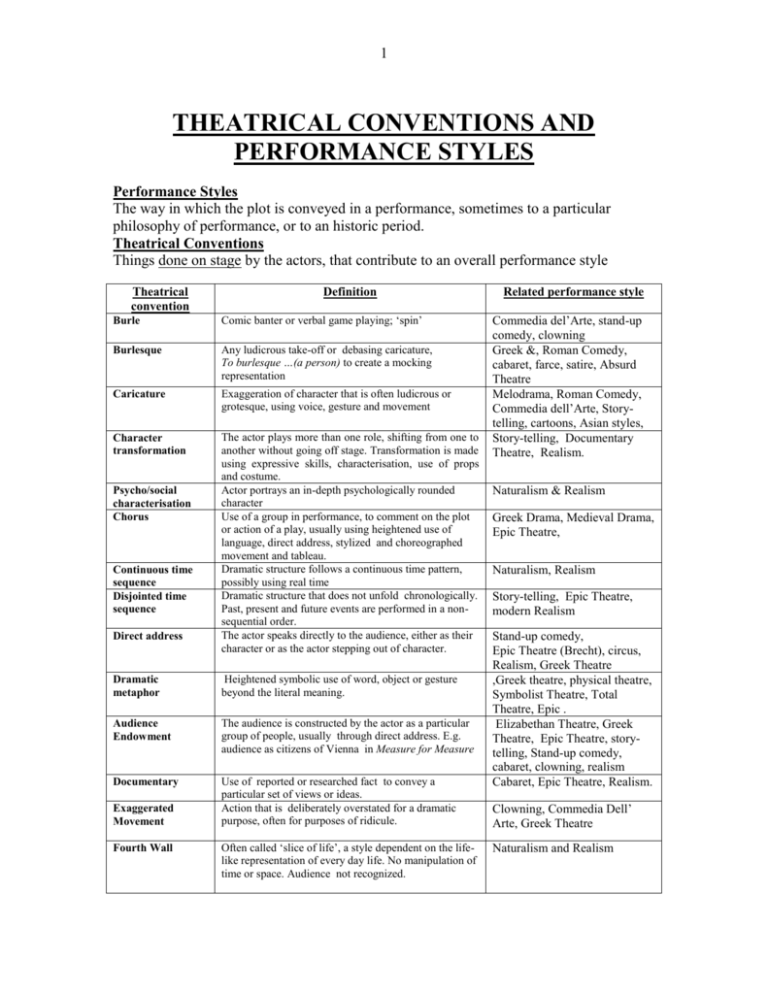
1 THEATRICAL CONVENTIONS AND PERFORMANCE STYLES Performance Styles The way in which the plot is conveyed in a performance, sometimes to a particular philosophy of performance, or to an historic period. Theatrical Conventions Things done on stage by the actors, that contribute to an overall performance style Theatrical convention Definition Burle Comic banter or verbal game playing; ‘spin’ Burlesque Any ludicrous take-off or debasing caricature, To burlesque …(a person) to create a mocking representation Caricature Exaggeration of character that is often ludicrous or grotesque, using voice, gesture and movement Character transformation The actor plays more than one role, shifting from one to another without going off stage. Transformation is made using expressive skills, characterisation, use of props and costume. Actor portrays an in-depth psychologically rounded character Use of a group in performance, to comment on the plot or action of a play, usually using heightened use of language, direct address, stylized and choreographed movement and tableau. Dramatic structure follows a continuous time pattern, possibly using real time Dramatic structure that does not unfold chronologically. Past, present and future events are performed in a nonsequential order. The actor speaks directly to the audience, either as their character or as the actor stepping out of character. Psycho/social characterisation Chorus Continuous time sequence Disjointed time sequence Direct address Dramatic metaphor Heightened symbolic use of word, object or gesture beyond the literal meaning. Audience Endowment The audience is constructed by the actor as a particular group of people, usually through direct address. E.g. audience as citizens of Vienna in Measure for Measure Documentary Use of reported or researched fact to convey a particular set of views or ideas. Action that is deliberately overstated for a dramatic purpose, often for purposes of ridicule. Exaggerated Movement Fourth Wall Often called ‘slice of life’, a style dependent on the lifelike representation of every day life. No manipulation of time or space. Audience not recognized. Related performance style Commedia del’Arte, stand-up comedy, clowning Greek &, Roman Comedy, cabaret, farce, satire, Absurd Theatre Melodrama, Roman Comedy, Commedia dell’Arte, Storytelling, cartoons, Asian styles, Story-telling, Documentary Theatre, Realism. Naturalism & Realism Greek Drama, Medieval Drama, Epic Theatre, Naturalism, Realism Story-telling, Epic Theatre, modern Realism Stand-up comedy, Epic Theatre (Brecht), circus, Realism, Greek Theatre ,Greek theatre, physical theatre, Symbolist Theatre, Total Theatre, Epic . Elizabethan Theatre, Greek Theatre, Epic Theatre, storytelling, Stand-up comedy, cabaret, clowning, realism Cabaret, Epic Theatre, Realism. Clowning, Commedia Dell’ Arte, Greek Theatre Naturalism and Realism 2 Heightened use of language Heightened use of movement Implied character Implied space Lazzo/ Lazzi (pl.) Lyrical Poetic or exaggerated use of language. Includes choice of words whose syntax, alliteration and rhyming patterns lead to heightened delivery. Ritualized, dance-like movement sequences either individually or in a group, often using repitition, symbolic gesture, Actor creates a sense of another person being present or addressed Actor creates a sense of a particular environment through voice and action A short comic routine based in a single ludicrous idea, often using sight gags, or slapstick. Use of verse, heightened song or movement, including the use of poetic imagery Mask Use of false noses, half masks, or full masks, for purposes of caricature, stereo-type, abstraction, or ready identification with known characters. Mime Montage Unvoiced physical performance implying object and space Juxtaposition of dramatic images or vignettes often presented in rapid succession uses: introduction of ideas summary of characters/events/actions. Narration Direct address where plot elements are conveyed Puppetry Satire Slapstick Stillness and Silence Soliloquy Song Stereo-type Transformation of Place Transformation of object Use of symbol Use of objects or puppets as characters Use of sarcasm, irony and ridicule in denouncing , exposing or deriding vice , folly and abuse. Comedy technique using physical humour, often stage violence Absence of sound or movement to enhance dramatic effect Monologue addressed to self to argue an issue. Usually has a thesis/antithesis or argument structure Use of song to break up or comment upon a narrative or plot Characterisation that uses highly recognisable simplistic or cliched character elements for dramatic purpose. The actor creates more than one place or setting without the use of scenery. This may be achieved using transformation of props or through use of expressive skills. A prop is used to represent more than one object Minimalist focus on objects to represent ideas Greek theatre, Epic Theatre various non-naturalistic Physical Theatre, Greek Theatre, Medieval Theatre ,Opera, Kabuki , Noh Drama, Asian performance styles, realism. Monologues, realism, Monologues, Realism, Elizabethan Theatre, Storytelling, Epic theatre, NonNaturalistic styles Commedia Dell’ Arte, other comedy. Greek Drama, Musicals. Opera. Asian performance styles, Elizabethan Theatre Clowning, Greek drama, Commedia dell’ Arte, Noh Drama, Kabuki, Other Asian performance styles Realism and non-naturalistic Story-telling, visual theatre, epic theatre, other nonnaturalistic styles. Story-telling, Epic Theatre, Stand-up, Realism Black Theatre, Visual Theatre, Shadow Puppetry, Bunraku, Object Theatre Asian styles Cabaret, stand-up comedy, Farce, Clowning, Sit. Coms, Clowning, Cabaret All styles Elizabethan Theatre, especially Shakespeare Opera, Musicals, Epic Theatre, Music Hall, Cabaret Melodrama, Commedia Dell’ Arte, Agit Prop., Sketch comedy. Cartoons, Cabaret Story-telling Story-telling and design styles which require minimal set. Realism, & Non-naturalistic styles, Ritual Theatre,


